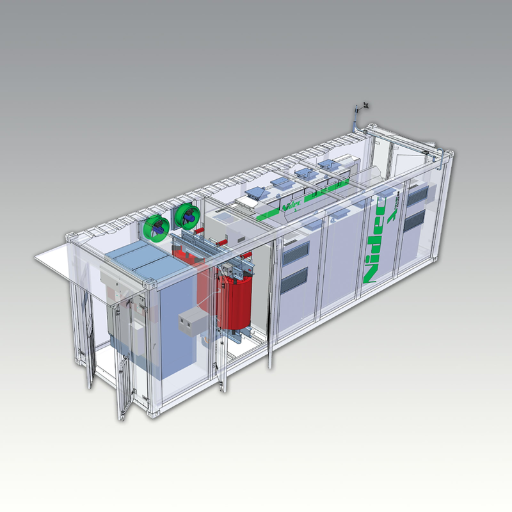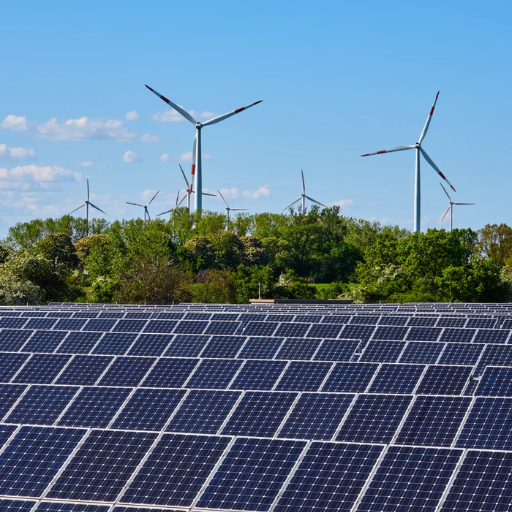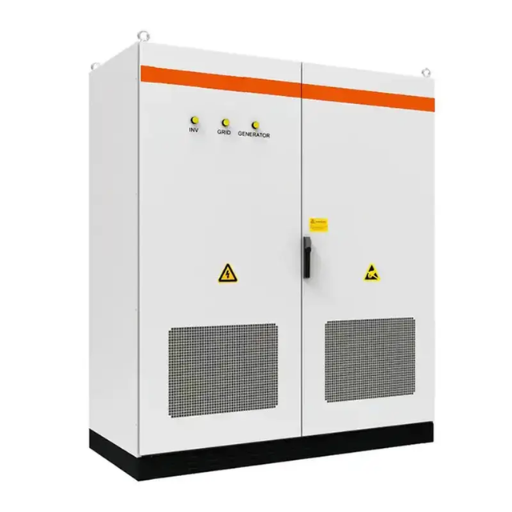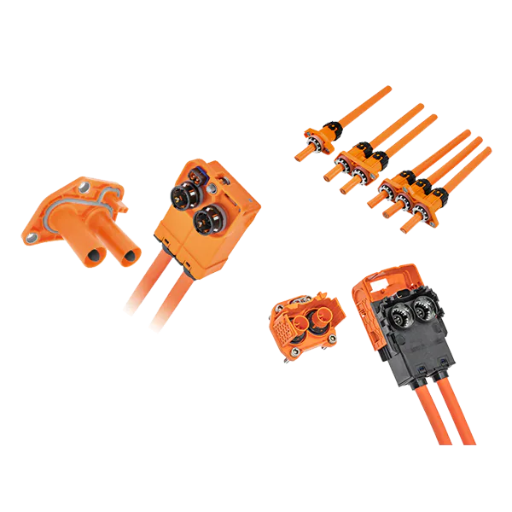Power conversion lines are essential to current and emerging electrical supply needs as they facilitate the efficient transformation of one form of energy into another for industrial, domestic, and critical technologies. They play a vital role in energy support, for example, ensuring power availability in situations where renewable energy sources are used or executing energy-intensive plants in a highly efficient manner.
Essentially, high-quality power conversion technologies play a crucial role in supporting significant energy production and transfer, ensuring stability and performance. This publication will provide an in-depth look at the essentials, historical, and emerging uses and advancements of power conversion technology in today’s world.
Understanding Power Conversion

Power conversion is the process of converting electrical energy into another form to meet the specific needs of the consumers. Dispensing with the technical details, this conversion may involve changing the voltage levels, switching from one current type (AC to DC, or vice versa), or adjusting the current power frequency to ensure the sound operation of the connected devices/systems. When providing this service, an end-user shall typically aim to maximize the power production of electricity generation systems and minimize the cost of electricity.
Power conversion technologies are strategies and devices used in crucial applications for society. These applications include the use of renewable energy sources, smart grids in power systems, manufacturing processes in factories, electronics for consumers, and electric vehicles that use electricity as fuel, which are the modern infrastructure of people’s lives and all seek to improve it.
Types of Power Converters
| Type of Power Converter | Function | Applications | Key Parameters |
|---|---|---|---|
| AC-DC Converter (Rectifier) | Converts AC to DC | Power supplies, battery charging | Voltage range, efficiency |
| DC-AC Converter (Inverter) | Converts DC to AC | Solar systems, UPS, electric vehicles | Frequency, waveform quality |
| DC-DC Converter | Changes DC voltage levels | Mobile devices, automotive systems | Input/output voltage ratio, ripple |
| AC-AC Converter | Modifies AC voltage, frequency, or phase | Motor speed control, HVAC systems | Frequency range, harmonic distortion |
| Bidirectional Converter | Allows energy flow in both directions | Energy storage, electric vehicles | Conversion efficiency, power capacity |
| Isolated Converter | Electrically isolates input and output | Medical devices, precision equipment | Isolation voltage, efficiency |
| Non-Isolated Converter | No electrical isolation between circuits | Consumer electronics, LED drivers | Size, cost, voltage regulation |
| Resonant Converter | Uses resonance for efficient power transfer | Wireless charging, high-frequency applications | Switching frequency, efficiency |
| Hybrid Converter | Combines multiple conversion types | Grid-tied renewables, advanced electronics | Versatility, system integration |
Importance of Power Conversion Solutions
Power conversion is a crucial practice for enhancing various types of power solutions, thereby facilitating seamless integration and interconnection with other systems. Today, renewable energy, Electric vehicles, and consumer electronic goods are widely adopted, which has escalated the need for efficient power conversion. Take, for instance, the case of grid-tied inverters for solar and wind power systems, which convert the electricity produced from a DC form that is not utility-friendly. Hence, they convert it to an AC output, allowing the electricity generated to be used on the utility grid. Additionally, in electric vehicles, the capital battery and essential systems are connected through DC-DC converters, which enable optimal energy distribution and preserve services for a longer period.
It is worth noting that in today’s modern power electronics, the use of wide-bandgap materials, such as silicon carbide (SiC) and gallium nitride (GaN), has led to significant enhancements in converter performance. These materials have enabled a higher frequency of changes, reduced heat losses, and hence a smaller size, which proves to be suitable for challenging applications involving high power or packed, closed designs.
The appreciation of the need for optimization in this context, combined with high-intensification development, makes power conversion solutions distinctly designed in cooperation with environmental concerns.
Power conversion systems are deemed indispensable in any modern community, especially in industrial, healthcare, and critical infrastructure sectors, as they ensure the reliability of operations by providing consistent power free from voltage fluctuations and power outages. The power supply systems contain many components that enhance power quality while minimizing losses. The development of such systems would also help improve not only the power sector but also conventional development methods.
Applications of Power Conversion Solutions

In this regard, power conversion solutions are widely used in many industries due to their increased energy efficiency and the ensured lack of platform downtime:
- Renewable Energy Systems: These systems are invaluable in further processing the energy captured by solar energy or wind energy panels and turbines for use on the grid.
- Data Centers: Power conversion technologies play a crucial role in ensuring a reliable and uninterrupted power supply, while also regulating voltage to protect critical hardware from power interruptions.
- Healthcare Equipment: Medical equipment requires highly accurate power management to function optimally; this effectiveness is most essential when the devices are applied in life-saving situations, such as ventilators or medical imaging equipment.
- Industrial Automation: Industrial processes additionally benefit from the emergence of smart grids. This is because the technologies help reduce operational costs by introducing efficient machinery, thereby contributing to the overall environmentally friendly nature of the manufacturing process.
- Transportation: More and more vehicles today use lithium, and unless the recovery and recycling of lithium become more energy-efficient and/or soon possible in both new and used batteries, this will pose a significant problem.
All these are just a few of the sectors where power conversion technologies thrive as well as are embraced as part, and specifically, the imperative part of infrastructural developments.
Power Conversion in Renewable Energy Systems
The effective functioning of renewable energy systems relies heavily on the efficient operation of power conversion technologies, which facilitate the seamless transfer of energy between different components within the system. For example, in a solar energy system, the power inverter is responsible for converting the direct current (DC) captured by the photovoltaic cell into alternating current (AC), which is most suitable for grid feed-in and household supply. At the same time, in another example, such as a wind energy system, highly sophisticated power converters help adjust the amount of electricity produced by the wind turbines, which fluctuate in terms of frequency and voltage, to output stable electric power as required by the electricity grid.
In recent years, new technologies have enabled the enhancement of efficiency, reliability, and profitability in the renewable energy sector. They introduced such devices as silicon carbide (SiC) and gallium nitride (GaN) semiconductors, which have the required switching speed, reduce losses, and have high thermal conductivity. This lowers electricity losses and ensures that energy from renewable resources is effectively utilized once the wind blows.
Any region that makes its utility plants as efficient as those in power plants will have more opportunities to recover from the negative consequences of energy loss caused by power plants. Efficiencies exceeding 98% in power conversion systems are so high that they result in a decrease in energy wastage in finding solutions to the problem of renewable resources.
Additionally, such systems help ensure the stability of the grid by allowing the smooth integration of renewable energy sources and energy storage, thereby enabling the continued supply of power even when there are changes in generation.
Industrial Applications of Power Converters
Renewable Energy Integration
Devices that facilitate the accommodation and stabilization of grid renewable energy inputs, such as wind generators or photovoltaic cells of solar, require power converters. A case in point is that solar panels are used in solar photovoltaic systems, which are converted to resistive loads using inverters and then transformed into a grid-friendly pulse. According to available statistics, solar inverters for utility-scale installations can achieve efficiencies of nearly 99%, maximizing yield while staying within the limits of power transmission rules.
Industrial Motor Drives
Variable Voltage Drop Drives (DMVDs) are to control the operation of electric motors in industrial applications such as assembly lines and conveyance systems accurately. They control the consumption of energy by controlling the speed of the motor according to the load requirements and various reports depict that savings of around 30% – 50% are possible with the use of VFDs in pump and fan applications.
HVDC Transmission Systems
HVDC power transmission systems utilize power converters designed to minimize energy losses during the transmission of power over long distances. The converter stations on both ends of the HVDC link effectively convert direct current into alternating current and vice versa, with a high transmission efficiency rate of about 95%-98%, unlike in AC systems.
Electric Vehicles (EVs) and Charging Infrastructure
EV power electronics ensure the vehicle battery is smoothly connected to the drive motor, with no losses experienced when the driver changes orientation and energy management is resumed nearest to the available onboard charging sources. These systems are also available in EV to V2G configuration, in that the generator can still function as an inverter that feeds power back into the electricity system. High-power DC fast chargers, which utilize state-of-the-art power electronics, enable speeds of up to 350 kW to be implemented for the rapid charging of electric vehicle batteries.
Uninterruptible Power Supply (UPS) Systems
During a power outage or voltage fluctuations, power conversions in UPS equipment are used to ensure a reliable power supply. Most of the time, these installations can be found in critical areas, such as data centers, hospitals, and the telecommunications industry. These modern UPS offerings, which have double conversion topology, also promise a formidable, shelf waste-saving conversion efficiency of more than 96%
Energy Storage Systems (ESS)
The Power Conversion System enables the efficient storage of energy in a bidirectional manner between the grid and energy storage devices, such as those containing lithium-ion batteries, as in the case of Power Conversion Technology. The systems aid in peak shifting and curtailment, load leveling as well as in maintaining the frequency and phase angle of the grid. The new ESS converters can exceed this forward and backwards efficiency range to 90%-95%.
Advancements in Power Conversion Technologies

Recent works in power conversion technologies have focused on improving efficiency, scalability, and the integration of renewable energy systems. The use of innovations such as silicon carbide (SiC) or gallium nitride (GaN)- based semiconductors has improved the overall performance of the device, reducing switching losses and increasing the operating temperature. They provide the technologies for making the devices more compact and cost-effective. Furthermore, the advent of digital controls has helped to improve the accuracy of the converters, allowing them to compensate for the loading variations which are prevalent in a grid. This also made it possible to install power systems with modifications, as well as add and remove units or modules without interfering with the whole or a significant part of the power plant’s operation. Such transformation is a stepping stone to a more resource-efficient energy sector.
Cutting-edge Inverter Designs
A major departure from traditional inverter architectures comes with the integration of a soft-switch. This fluorite, in large quantities, validated the operation of the diode as a block for inhibiting diode conduction under overvoltage operation conditions. A chopper gate drive circuit innovation improved the design and performance of the system, and the results were published. Conventional diodes cannot meet the low front-end equipment coordination and deterministic response times for this application.
Innovative approaches to keeping the system cool, such as the use of liquid cooling systems and combined thermal management systems, make inverters even more effective in terms of heat dissipation. Furthermore, the incorporation of artificial intelligence and machine learning algorithms into inverter control functions paves the way for the implementation of adaptive control, online diagnostics, and forecasting capabilities, among others. Such steps serve to increase energy availability and utilization while reducing the inherent energy losses, as well as minimizing repair costs. All these efforts would be in the wind, that is, to support these emerging energy solutions.
There is no problem in scaling up the designs as needed when utilizing any of the modular inverter designs. Platforms to which this energy is connected benefit from the ease of expansion and rapid commissioning, thanks to modularity. It is in this context that the significance of advanced and innovative inverter technology comes to the fore in the overall scheme of developing a reliable and environmentally friendly energy arsenal.
Frequency Converters and Their Applications
Among the many tools, frequency converters operate under conditions that are drive-guided systems, which in recent years have become a fundamental aspect not only of home appliances and consumer electronics, but also of industrial and commercial installations. Each of the applications of converters serves its own purposes and functions, and hence uses other operating points, where it consumes significantly less power and allows a greater portion of the national energy system’s reserves to be utilized.
In the HVAC sector, frequency drives are a typical application. They allow for variable changes in fan or pump output, enabling efficient handling of power or power consumption during off-peak hours. This is not only the case for industry but also in manufacturing systems, because, based on equipment such as conveyors, mills, and assembly lines, among others, consistent and simultaneous activities are possible when frequency converters are used. These sectors begin with shipping and transport services, and include, of course, the railway industry.
Current trends in research and development in frequency converter technology are shifting towards compact units, improved thermal dissipation features, and more client-oriented software for remote control. Accordingly, these advances confirm to numerous users the integral function of frequency changers in industrial technology and energy applications, and as such, satisfy the demand for systems with improved dependability, scalability, and reduced environmental impact required in operating systems.
Reliability and Efficiency in Power Conversion Systems

System reliability and efficiency are primary considerations in power conversion systems, as they significantly impact the system’s operational efficiency and the corresponding amount of energy usage. The systems will often be designed to operate effectively under harsh and unfavorable conditions with minimal downtime by utilizing durable elements and accounting for failure probabilities. Much of the energy productivity is often realized through the reduction of productive losses in the conversion process, which is a key factor in achieving the less costly nature of operation and investment required to meet sustainability objectives. State-of-the-art designs utilize top-quality equipment, intelligent software, and innovative engineering requirements and practices to enhance viability, reliability, and reduce power consumption in various domains.
Building Rugged and Durable Power Converters
Manufacturing stable and durable power converters, therefore, involves considerable attention to both environmental and operational problems. In particular, it is essential to predict the effects of certain materials on the processes of degradation caused by an aggressive environment, due to heat effects or excessive loads. Thus, different types of insulated gate bipolar transistors (IGBTs) with superior thermal characteristics are the most effective in minimizing distortion, even in harsh high-temperature cycling conditions.
Progressive heat transfer systems, such as advanced heat sinks, phase-change materials, and liquid cooling equipment, are essential in mitigating heat. Besides, due to the increased voltage and power capacity, and the increased efficiency, these materials are in respect of the in amounts of silicon carbide (SiC), gallium nitride (GaN), and wide band gap semiconductor durability in the form of active power electronics of ultra high voltage and temperature operation cycle, debunking the movement loss expenditure.
EMC (Electromagnetic Compatibility) shields are equally important, as malfunction-free operation is ensured even in high electromagnetic noise conditions typical of industrial environments. Moreover, using protective coatings, haircut enclosures, robust seals, and condition r-t unconventional convertors against possible effects of moisture, dust, and vibration when these industrial conditions are severe. Altogether, these design components significantly shape power conversion systems, which are called modern industrial, transportation, and renewable energy facilities.
Energy Efficiency Improvements in Power Conversion
Over recent years, the enhancement in energy efficiency associated with power conversion center devices has received significant thrust from the use of wide-bandgap (WBG) semiconductor materials, such as silicon carbide (SiC) and gallium nitride (GaN). These materials exhibit high-quality electrical properties, facilitating the ease of electricity flow and resulting in low energy loss. Among these, higher breakdown voltages, faster switching frequencies, and high levels of thermal conductivity are some of the prominent characteristics that help reduce energy losses during power conversion. High-power and high-speed designs in EVs and power sources that utilize green energy and even industrial power sources are beginning to deploy N-type doping in GaN:Si.
But that’s not all! There’s more to MPPT than just changing voltage. It needs to optimize both the voltage and the actual power delivered by the element to maximize efficient power. Among the most minimal MPPT algorithms are the P&O, FPN, and IncCond MPPT algorithms. Maximum power efficiency can also be achieved using the weakest system load possible. Finally, the way I also want to elaborate on in detail is the adjustment of the oscillation power level.
Challenges in time series prediction mainly include the interaction between the underlying relationships in seasonality or long-memory components and the nonstationary features present in the time series data, such as trends, cyclical nature, trading day effects, and other seasonal effects, all of which make prediction more difficult and less accurate.
The Future of Power Conversion Solutions

Thus, with power conversion technology, good sections focus on efficiency as the first principle, in contrast to the concept of how much power is used. This approach takes into account the development of new technologies, such as resonant converters, which enable the power obtained from a piezoelectric generator to be supplied to the load at a point where its electrical characteristics are close to its mechanical resonant frequency. The energy management activities of this smart appliance, along with the underwater acoustic sensor, are automatically optimized. These best practices aim to update standards to reduce the stressors posed by emerging technologies to the environment, which is a fundamental restriction addressed owing to negative externalities on businesses as well as public health— With the term energy efficiency refers a policy concept centered on improving energy economy.
Emerging Technologies in Power Conversion
A new and glorious era, where efficiency, effectiveness, and standards are aligned, is on the horizon as a result of the introduction of solid-state transformers, a technology leader in SST (solid-state transformers). Its coils are different from those in general transformers in that these high- and low-voltage coils do not separate; solid-state transformers can be controlled by signals varying in magnitude and phase without the need for thick magnetic cores. These transformers, which are small enough to be built inside wind turbines or photovoltaic panel cells, are especially useful in today’s power systems. Solid-state transformers are also suitable for microgrid applications, eliminating the need for central energy generation; hence, power replacement and energy balance are achieved. Another advantage of SST infrastructure is that it enables EV charging terminals, which provide a bidirectional power supply, aligning perfectly with the development of industry technology for renewable energy.
The next stage of power electronics development is associated with the use of semiconductor components with wide forbidden bands. Such a concept is related to new materials, such as silicon carbide (SiC) and gallium nitride (GaN), which currently represent the cutting edge of power conversion. Such materials enable enhanced heat dissipation characteristics, withstand great electrical stress without breakdown, have shorter turn-on times than conventional silicon-based materials, and suppress soft-switching turn-off tail mechanisms. These high-performance WBG devices are made possible because their physical properties can enable improved energy conversion efficiency in solar power generation and also in other rolling stock systems. It is clear that WBG applications will intensify with the increasing demand for energy consumption efficiency and more restrictive environmental standards, as well as the need for more efficient power conversion means.
The Role of Electrification in Energy Transition
An essential element in the restructuring of the modern world is the role of electrification, which promotes the shift away from traditional fossil fuels in favor of greener energy sources. This is achievable through the conversion of energy-intensive branches, such as transportation, construction, and industrial activities, to use electricity, significantly mitigating the effects of global warming and climate change, as determined by various multilateral environmental agreements. The use of electric cars is already here and has helped part of the population reduce its overdependence on petroleum. This issue has been known to escalate its climatic effects and even local environmental hazards.
Moreover, the development of renewable energy sources – such as wind, solar, and hydroelectric power – has created more opportunities for the generation of low-carbon electricity. Technologies like advanced interstate system batteries and lithium-ion storage units for renewable power generation have the flaw of production control, which ensures a relatively stable working of the electrical grid’s power and provides an energy supply irrespective of unpredictable demand. According to the most recent estimates, a subheading of the two principal sectors, residential and commercial segments, explored heat pump integration in electric cooling and electric heating systems with advanced thermodynamic technologies to conserve energy.
However, on a global level, policies promoting the use of electricity spearheaded such investment since such policies have accelerated the construction of the infrastructure on account of the ‘stringent environmental requirements’ and the need to promote the use of renewable energy by improving electrification in various sectors of the economy. It is evident from the predicted demand for energy that electrification shall not be an additional option to assist anything but constituent articulation in the government’s roadmap for steering towards zero-energy level.
Reference Sources
1. Fabrication of Titanium Dioxide Nanowires for Dye-Sensitized Solar Cells
- Methodology: Hydrothermal synthesis of TiO₂ nanowires on fluoride-doped tin oxide (FTO) glass, combined with graphene nanoplatelets as counter electrodes.
- Key Findings: The nanowires enhanced dye adsorption and light-harvesting efficiency, achieving a fill factor of 0.304 under specific light conditions.
2. Performance Improvement of Dye-Sensitized Solar Cells Using Vanadium Oxide
- Methodology: Treated TiO₂ mesoporous layers and Pt counter electrodes with vanadium oxide additives.
- Key Findings: Enhanced electrical performance, with PCE increasing from 8.25% to 9.10% for treated photoanodes.
Frequently Asked Questions (FAQs)
Q: What are power conversion solutions?
A: Power conversion solutions basically involve the technology and systems used in the conversion of electrical energy from one form to another, for example, the conversion of AC to DC or changing voltage levels. This is essential in many disciplines, such as renewable energy, electric vehicles, and industrial automation systems, and it aids in reducing energy wastage and utilizing alternative energy sources. As years pass and technology advances, current power conversion solutions are equipped with enhanced features for efficient monitoring and control. Furthermore, these particular solutions are also necessary for enhancing grid services.
Q: Why are power conversion solutions important in renewable energy?
A: Power conversion solutions have become an essential component in renewable energy, an advancement that allows the use of solar panels and wind turbines. The purpose of the equipment is to allow solar panels, for instance, which produce direct current power, to provide alternating current power to the grid. Additionally, they also develop the control strategy for most grid energy storage systems, particularly for battery storage alone. These strategies aim to enhance the efficiency of renewable energy systems and improve grid support. Rather than just hoping for the best with renewables, what is clear is that there is a potentially more intelligent and strategic approach that can be employed.
Q: How do power conversion solutions improve energy efficiency?
A: It is well known that energy light Conversion processes offer ample room for different efficiency improvement strategies, which have the effect of reducing energy losses during power conversion processes. High-frequency conversions, for example, make it considerably easier to switch actions, which consequently leads to an increase in the efficiency of energy conversion within converters and inverters. They make it easy for load handling to be done more efficiently, that is, the energy serving the loads is made available when it is needed and in the necessary dosages only. Energy conversion systems designed with energy savings in mind are beneficial in terms of affordability and ecological concerns. Lastly, they empower one to deploy energy structures based on non-fossil energy sources in the layout to make the arrangement more eco-friendly.
Q: What factors should be considered when choosing a power conversion solution?
A: When choosing a power conversion solution, there are many considerations to be made, such as efficiency, size, and how to make it fit with the existing ones. The efficiency ratings denote how much energy is utilized in the given solution and are one of the most essential criteria for effectiveness in terms of overall cost. The load of the expected system and the actual system should be approximately equal to prevent low productivity and avoid overloading. To operate more or less harmoniously, there is a need to comply with the standards for integrating renewable sources and the power network. In addition, monetary costs, geometry, and complexity of implementing the device for the structure should contribute to the concepts to be evaluated, defining required characteristics that are more restrictive.
